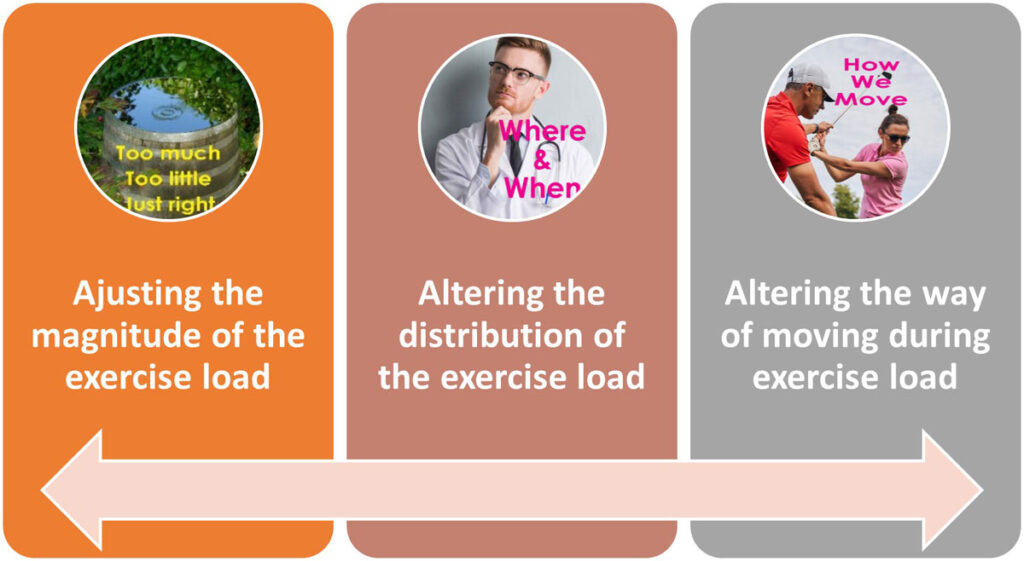Adjusting the exercise load to manage musculoskeletal pain syndrome

Adjusting the amount of exercise load involves seeking a balance between increasing or decreasing the load.
Athletes and healthy individuals the bias is towards increasing the load to improve capacity and performance.
For musculoskeletal injuries, post-orthopedic surgery, or musculoskeletal pain syndromes, the bias is towards decreasing the load to facilitate healing and recovery.
Tactics to decrease the exercise load encompass:
- Adjusting the magnitude of the exercise load
- Altering the distribution of the exercise load - changing when and where loading occurs.
- Altering the way of moving during exercise load.
Adjusting the magnitude of the exercise load
Musculoskeletal pain syndromes require consideration of the symptoms of pain while adjusting the magnitude of the exercise load.
The following are previous blog articles providing specifics on how to use the symptoms of pain to adjust the magnitude of load during exercise.
- Pain – what does it feel like? How this information can guide treatment.
- Movement-evoked pain measurement for adjustment of intervention for chronic musculoskeletal pain syndromes.
- Using symptoms &/or sign modification procedure to manage musculoskeletal pain syndrome.
- Pain - Movement/
- Choices of intervention for musculoskeletal pain syndromes: decrease pain, improve impairment, resolve dysfunction.
- Surgical vs non-surgical intervention – decision for musculoskeletal pain syndrome.
Altering the distribution of exercise load for musculoskeletal pain syndromes – changing when and where the loading occurs
Mechanical loads are forces or weights that act on the body and tissues causing stress, strain, deformation, acceleration, or displacement.

Groucho Marx hosted a TV quiz show called “You Bet Your Life” in the 1950s. Sometimes, when a contestant did poorly, he would ask an easy question so that the person could win a prize. For example, who is buried in Grant’s tomb?
This question refers to the mausoleum that contains the remains of Ulysses Grant. The answer that Groucho expected to hear was “Grant,” & this allowed him to award a prize.
The easy question when a patient presents with musculoskeletal pain syndrome is “How can you decrease the load when exercising?
For many individuals with musculoskeletal pain syndrome, the answer is to decrease body weight.
The prize is less pain.
In biomechanics “load” refers to the force acting on the body or its structures. Ground reaction force is a measure of load. When walking or running at a similar speed the magnitude of ground reaction force varies very little.
However, interventions can vary when the ground reaction force/load reaches a joint structure or tissue.
Multiple tactics can alter when and where the ground reaction forces impart to the body including footwear changes, shoe inserts, braces, off-loading braces, compression garments, and the use of canes/sticks.
Using a shoe with a rocker sole will change by milliseconds when the peak force/load reaches the heel versus the ball of the foot.
Using a knee unloading brace can alter where the peak force at the knee occurs from the knee's medial aspect to the knee's lateral aspect.
Here are more examples of musculoskeletal pain syndromes that can benefit from when and where the load/force is occurring.
- Back & neck pain
- Knee osteoarthritis unloading brace
- Hip osteoarthritis unloading brace
- Shoulder rotator cuff brace
- Footwear
- Compression garments
- Use of stick/cane

Altering the distribution of the exercise load is analogous to the use of scaffolding which can provide temporary support to allow healing and recovery to occur.
Of course, there are times when external support or scaffolding can be a long-term or permanent intervention.
Altering the way of moving during exercise load
If pain occurs with movement, then observation and analysis of movement are essential.
The following are previous blog articles providing specifics of how altering the way of moving during exercise load and/or activity can decrease pain.
- Deviant movement resulting in pain – Excessive Toe Out Gait.
- Sensory preference & learning optimal movement.
- Using symptoms &/or sign modification procedure to manage musculoskeletal pain syndrome.
- Path of least resistance is not always the best option – sometimes it is better to have some stiffness.
- “Deme Bones” – inter-limb deviation related to musculoskeletal pain syndromes.
- Choices of intervention for musculoskeletal pain syndromes: decrease pain, improve impairment, resolve dysfunction;
- Walk this way – Run this way.
- Whole vs part method of learning to walk/run a new way: deviant to less deviant.
- Gait deviations clustering gait deviations – injury – new data.
- Total knee joint replacement – Are you satisfied? Gait Analysis.
- It’s not hip to be in pain – Gait analysis & training can improve those pain in the backside.
The information on this website is not intended or implied to be a substitute for professional medical advice, diagnosis, or treatment. You are encouraged to perform additional research regarding any information contained available through this website with other sources and consult with your physician.
Damien Howell Physical Therapy – 804-647-9499 – Fax: 866-879-8591 At-Home, At Office, At Fitness Facility – I come to you, I do home visits Damien@damienhowellpt.com
